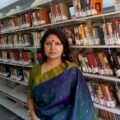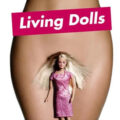Concern for the Destiny of the Country: Indian Feminist Novels
 Indian literary critic Meenakshi Mukherjee has said that the essential concern of the twentieth-century Indian novelist was the changing national scene and the destiny of the country. She was referring to novels of the first half of the twentieth century, but these same concerns continue to operate today. It is only the definition of what the “destiny of the country” means that has changed over the decades. The concerns to which she refers are not confined to the Independence struggle, but increasingly turn toward problems of class and gender. Three novels—Urdu author Qurratulain Hyder’s classic My Temples, Too, English-language author Shruti Saxena’s Stilettos in the Boardroom, and Tamil author Vaasanthi’s Birthright; all published by India’s two leading feminist presses, Zubaan and Women Unlimited—highlight the changing nature of national destiny. Though these novels differ in both style and content, their central characters face renegotiations of youth, class, and gender, in the shadow of post-Independence national identity. These works not only reveal the shifting ground of Mukherjee’s concern, but also demonstrate that there is no such thing as a representative Indian feminist novel. In these titles, diversity is privileged above adherence to ideology. Each one expresses a different India—newly independent, ruling class, revolutionary, Muslim; urban, globalising, corporate; rural, educated, tradition-bound—all with women’s experiences at their center.
Indian literary critic Meenakshi Mukherjee has said that the essential concern of the twentieth-century Indian novelist was the changing national scene and the destiny of the country. She was referring to novels of the first half of the twentieth century, but these same concerns continue to operate today. It is only the definition of what the “destiny of the country” means that has changed over the decades. The concerns to which she refers are not confined to the Independence struggle, but increasingly turn toward problems of class and gender. Three novels—Urdu author Qurratulain Hyder’s classic My Temples, Too, English-language author Shruti Saxena’s Stilettos in the Boardroom, and Tamil author Vaasanthi’s Birthright; all published by India’s two leading feminist presses, Zubaan and Women Unlimited—highlight the changing nature of national destiny. Though these novels differ in both style and content, their central characters face renegotiations of youth, class, and gender, in the shadow of post-Independence national identity. These works not only reveal the shifting ground of Mukherjee’s concern, but also demonstrate that there is no such thing as a representative Indian feminist novel. In these titles, diversity is privileged above adherence to ideology. Each one expresses a different India—newly independent, ruling class, revolutionary, Muslim; urban, globalising, corporate; rural, educated, tradition-bound—all with women’s experiences at their center.
Qurratulain Hyder (1928-2007) wrote Mere Bhi Sanamkhane in 1947 at age nineteen. She was unusual in translating (or “transcreating,” the term she preferred,) many of her novels herself: Mere Bhi Sanamkhane was transcreated as My Temples, Too. The novel is set in Lucknow, long a cosmopolitan center with a combination of Muslim and Hindu inhabitants, in the lead-up to and aftermath of Indian Independence. Founded in 1775 when the Muslim nawabs of Avadh shifted court there, Lucknow had a large and well-educated Hindu middle-class. Though the monarchy fell to the British in 1856, the traditional feudal system that upheld high-cultural traditions (poetry, arts, and music) lasted until Independence in 1947. My Temples, Too depicts a post-Independence period of growing suspicion and animosity between religious groups, when large numbers of Punjabi refugees were entering Lucknow. Hyder’s novel documents the rapid disintegration of the city—and, by extension, India—as an ideal of Hindu-Muslim unity that would prove unattainable.
My Temples, Too is different from many other Partition novels, such as Khushwant Singh’s Train to Pakistan (1956), Bisham Sahni’s Tamas (1974), or Bapsi Sidhwa’s Cracking India/Ice-Candy Man (1988); it deals with a localised group of youth from privileged backgrounds, rather than a “list of horrors” or a “border communities ripped asunder”. In depicting Lucknow as a site of political and cultural change rather than intense corporeal violence, Hyder’s novel is more akin to Attia Hosain’s Sunlight on a Broken Column (1961). The focus on divided families, shattered lives and trust was an early concern of female writers of Partition, only later taken up by male writers. Though Hyder may not have called herself a feminist, her focus on emotional trauma and change sets her apart from her male contemporaries, and she articulates specifically female interpretations of and response to history. As publisher Ritu Menon has indicated, even if Hyder didn’t call herself a feminist, her writing itself is evidence of her intention to be subversive from a gendered perspective. A postcolonial feminist reading of literature is expansive enough to encompass works that do not adhere to commonly perceived notions of feminism.
Hyder was certainly politically progressive, though perhaps aloof from the political and literary movements of her time. Though she was not a member of the Progressive Writer’s Association—an Indian literary movement primarily made up of left-wing Hindi and Urdu writers, formed in the 1930s, with a presence in Lucknow—she is likely to have been influenced by them. The PWA have been described by critic Jason Francisco as “the single greatest literary origin of Partition writing”, iterating their “disgust, disillusionment and horror” over the event. Like the PWA, Hyder’s writing maintains opposition both to the British colonial leadership and to conservative Indian society.
Many of the characters in My Temples, Too belong to upper- or ruling-class Muslim families; the novel is as critical of the feudal system that structured Muslim society at the time—in which wealthy landlords patronized tenant workers, a system particularly ingrained in Northern India and Lucklow—as it is of Partition. Hyder describes the denial of the middle-class, who seem to take Indo-Muslim civilisation for granted, through the elderly character Kunwar Sahib:
He still didn’t want to believe that the two communities were swiftly pulling apart. He sat in his cosy drawing-room reciting Urdu poetry with his Hindu Talukdar friends, and fancied himself a solid rock of the Old Order.
This contrasts with the younger generation, actively involved in instigating change without fully understanding the magnitude of the events taking place:
This was a motley crowd of young student workers from all kinds of backgrounds. Feudal. Middle Class. Peasant. They were liberals, and fire-eating revolutionaries, and mild, scholarly left-wingers, vegetarians and pacifists. Their chief occupation was day-dreaming. […] Their lives were a great big, exciting, very full-blooded Movement on the whole. They led strikes and went to jail and studied agrarian reform and social reform and all manner of other reforms. They mostly wore rough handloom cotton and sang Tagore’s songs and wrote about realism in literature. They were anti-British and passionately believed in Hindu-Muslim Unity, and discussed how the capitalists and the bourgeoisie of both the Hindu and Muslim communities had conspired among themselves to keep the masses down.
The novel is sceptical of the youths’ idealism. Hyder writes, “their prototypes could be found in university towns around the world.” The motivations behind their revolutionary thought are attributed to mere youth itself, which undermines any claim to serious political intent.
My Temples, Too dramatizes the shift from the old, feudal social organisation of north India, where aristocratic families ruled, to an independent India in which land and property were redistributed and Muslims marginalised. Hyder positions the tension between the old and new as a choice the younger generation had to make, just as she herself had to choose between India and Pakistan. Amit Chaudhuri has suggested that the “responsibility of choice” Hyder faced gives her writing a “haunting, existential quality.” A great uncertainty over this choice and the future it represents is expressed throughout the novel.
After Partition Hyder went to Pakistan, then spent a few years in London in the 1950s before returning to India in 1961, where she remained for the rest of her life. Mere Bhi Sanamkhane was written in the last months of 1947, immediately after Independence and Partition, and narrates events that were still taking place at the time. The full extent of the loss of culture and community was only just being revealed, but Hyder demonstrates an astute awareness of what these momentous events would mean for the history, and the future, of India. The fractures in South Asian Hindu-Muslim relationships were to prove much deeper than the corporeal violence immediately obvious in 1947, and the milieu that Hyder limns in My Temples, Too suggests this. Iconic, male-authored works of Partition literature—such as Singh’s Train to Pakistan or Saadat Hasan Manto’s Toba Tek Singh—have a very different focus. How she considers the destiny of the country emerging has links to the male-dominated literary spheres that she was a part of, but is uniquely insightful at the same time.
Six decades since, in another period of upheaval in India—post-economic liberalisation, which began in 1991—a proliferation of Indian books and authors are seen who could be categorised under the rather slippery label of popular fiction. Much Indian popular fiction centres on the lives of the educated, urban, English-speaking elite, which is also their target audience. Characters are generally middle-class, the cross-section of society benefiting from economic liberalisation, with aspirations of social mobility. They are also young, grappling with identity crises brought about by the “clash” of tradition and contemporary life. The echoes between these novels and Hyder’s early, somewhat iconoclastic work are clear. Two decades after the liberalisation of the Indian economy, now that the financial power of the middle classes and young professionals is increasing, urban, middle-class Indians are experiencing monumental changes to their lifestyle and work opportunities.
Shruti Saxena’s 2010 novel, Stilettos in the Boardroom, is set in BankPro, a business process outsourcing (BPO) company in Gurgaon, a new suburb of Delhi. It revolves around three female characters: Sarahna, a young woman who takes a job at BankPro to avoid marriage; Shivaa, a thirty-something married career woman; and Arya, a manager with successive office romances. Sarahna battles with her mother over taking the job, as the latter wants her daughter to marry and stay home. Shivaa suspects her husband of being unfaithful as she works such long hours that she hardly sees him. Arya is trying to overcome an unpleasant experience from her past, when she was offered a promotion in exchange for sex. Saxena identifies the main problems confronting these characters, and thus contemporary professional women in India more generally, as sexual harassment, work-life (im)balance, and family disapproval. Stilettos presents the IT-enabled sector as a place of potential but ultimately frustrated liberation for women. Writer-politician Shashi Tharoor writes:
To many, the call center has become the symbol of India’s rapidly globalizing economy. While traditional India sleeps, a dynamic population of highly skilled, articulate professionals works through the night, functioning on U.S. time under made-up American aliases. They feign familiarity with a culture and climate they’ve never experienced, earn salaries that their elders couldn’t have imagined (but still a fraction of what an American would make), and enjoy a lifestyle that’s a cocktail of premature affluence and ersatz Westernization.
This industry employs around two million workers, largely young university graduates. BPO jobs are among the best-paid in India for young people, though a certain level of education and English-language skill is required. This means that BPO workers are firmly part of India’s socio-economic elite. Women are also highly visible in this workforce. In India, where “respectable” jobs for women have traditionally been teaching, nursing, and secretarial work, the visibility of women in the IT-enabled sector can be bracing to conservatives. Though the foreign investment and employment opportunities have been widely celebrated, the attendant cultural change has been less openly embraced. As Shehzad Nadeem suggests, the clash between the celebration and the anxiety engendered by the growth of BPOs supposes two different moral worlds:
The first is one in which marriage is arranged by family, gratification is delayed, and the individual is engulfed and defined by a dense web of family and social obligations. The second posits an autonomous, pleasure-seeking self that no doubt derives succour from family, but is defined more by the voluntary choices it makes.
Liberalization and globalisation are shaping the aspirations and identities of the Indian middle-class. It is within this fraught new setting that Saxena sets her novel.
Clothing is a social signifier that can reveal a lot about perceptions and practices of subjectivity. In Stilettos, traditional Indian cultural markers are un-cool, contrasted with things that are perceived as being western. Sarahna, for instance, faces hostility from her mother over her decision to work at BankPro because she immediately cuts her long hair and dons a pair of jeans. When she goes to BankPro for her interview, Sarahna takes careful notice of the appearance of the other employees: “Girls in her college were never allowed to dress like this. This place opened up a whole new world of opportunities, not just for one’s career but also personal development”.
Personal appearance is equated with personal development because it is understood that shunning the outward symbols of Indian womanhood—the long, plaited hair and Punjabi salwar kameez that Sarahna wears to her job interview—represents a desire to become more western, and therefore modern. Young women are presented as a metonym for broader social change, and freedom in Stilettos is a function of consumerism as well as the fulfillment of personal desires (the latter, interestingly, a typical characteristic associated with the “chick lit” genre). In the world of BPOs presented in Stilettos, women cannot have successful or fulfilling independent careers, or lives, unless they break with tradition. The struggles of contemporary Indian women are met with a feminist liberation ideology underpinned by western consumerism.
Related to the co-mingling of young men and women, another uniquely modern concept is explored: sexual harassment. Though the harassment of women in public spaces is no new phenomenon—not by any stretch—the prohibition and legal structures around it are relatively young. As might be expected, Stilettos condemns sexual harassment when it appears in obvious and indisputable ways, such as pressure to have sex in exchange for career advancement. However, the novel may still be perpetuating attitudes that reinforce the sexual objectification of women, and, ironically enough, could authorize behaviors such as sexual harassment.
In Chetan Bhagat’s novel One Night at the Call Centre, the narrator Shyam notes: “I saw Vroom stare at Esha. It’s never easy for guys to work in an office with a hot girl. I mean, what are you supposed to do? Ignore their sexiness and stare at your computer?” Perhaps meant in a flippant tone, this comment reveals the objectification that women face on a regular basis. In this instance, Shyam is describing a workplace crush—but by describing it the way he does, Shyam projects upon Esha, the object of the gaze, the aura of sexual seduction. He is suggesting that Esha is herself at fault for luring Vroom’s attention. It is easy to see how such presumptions become, within a few short logical steps, a defence of sexual assault and harassment.
In Stilettos, Saxena attempts to correct this patriarchal scenario, in which women are perceived to be at fault for men’s inability to mediate their own desires. In Saxena’s novel, female characters are repeatedly shown objectifying men, talking about who is hot in a way conventionally reserved for the boys. But despite her attempt to present strong, independent women accepting their own desires, Saxena’s reversion to sexist language is shocking, not to mention ham-handed. It does little or nothing to mitigate sexist attitudes or language. Consider this scene, when the tough, beautiful manager Arya first encounters Sam, a colleague with whom she develops a relationship:
Just because she was good looking, did not mean she was dumb. But, in spite of everything, he was quite cute. He donned a slight American accent, nothing pretentious, though. But he was not her type. He was mature looking and much more suave than she liked her men. She really liked the tough guys, who would carry her on their shoulders and spank her if she was wicked! And since she usually was, she got punished quite often.
Sam begins as the object here, being appraised by Arya—but somehow, by the end, Arya has become the object and is reduced to a caricature of a sexually objectified woman. Objectification turns back on itself, revealing the essentially dehumanizing effect it has not only on the person observed but also the observer.
Younger Indian female writers are rightfully credited for their bold use of language, especially English, and with their willingness to discuss sexuality, something that remains difficult for older generations. However, there is nothing inherently progressive or liberating in descriptions of sex or expressions of sexuality. These depictions must also be matched with an understanding of what historical and social forces have shaped those attitudes. The passage above is intended to be playful, but it reinforces patriarchal notions of sexuality, and it is jarring in a novel published by an openly feminist press. This language undercuts Saxena’s attempts to be serious about the problem of sexual harassment. It suggests that misogynistic language is acceptable so long as it is also available to women, that it is frivolous and harmless, and that only when such language is put into practice does it become a problem. This elides the fact that language and actions are deeply interconnected. Stilettos attempts to locate women’s experiences within the “new” India, and while it does expose some of the tensions women must grapple with, it unfortunately undercuts its own effect by reinscribing women within patriarchal norms.
Though My Temples, Too and Stilettos are very different types of novel, they are both set in a time of significant social upheaval, and both outline how women are situated in society at these times. Neither is explicitly feminist; or rather, in neither do the characters expound feminist views or causes, nor are the main themes immediately identifiable as feminist causes in Indian culture (such as sexual assault, domestic violence, dowry, sex work). It has been suggested that the overt explication of feminism in literature can make for poor writing, lacking subtlety. Shashi Deshpande does not believe that every aspect of her writing should propagate feminism:
Why must I, each time I write a novel, present pictures of rebellion? Because I am a feminist? For God’s sake, I’m a novelist, I write novels, not feminist tracts. Read my novel as a novel, not as a piece of work that intends to propagate feminism.Of course, given my ideas about women and their roles in life, I am looking at the world in a particular way, I am asking many questions through the novel and its characters, but I do not provide any answers. And I consider that to bring polemic into fiction writing, to work out a feminist propaganda through my characters, is to create flawed writing.
Of course, any issue or event can be viewed through a feminist lens, and perhaps the writing and publication of feminist “tracts” is counter-productive in that they promote a narrow view of the movement. However, some contemporary novels published by Indian feminist presses are explicitly feminist in content, are framed as such, and they advance the idea that Indian feminism is a broad, accommodating category rather than a restrictive one.
One example is Vaasanthi’s 2004 novel, Birthright, translated from Tamil. The “birthright” of the title bears two meanings: sex-selective abortion and women’s inheritance rights. The narrator, Mano, is a doctor in her late twenties living in a village in Tamil Nadu, her “native place”, with her father. A large part of Mano’s work involves aborting female foetuses after conducting sex-determination tests. Mano believes she is providing a necessary service to women who may otherwise face abuse from their marital families for giving birth to girls. In her personal life, Mano has a conflicted relationship with her father.
As an only child, and a daughter, Mano has long sought the approval of her father, now widowed and ailing, in all matters. Despite having a lover in Bangalore, Mano has not married him because she does not want to leave her ancestral home to live in her husband’s house, as tradition dictates. Being an only child, Mano also believes that her father’s house, mill, and extensive properties are her “birthright,” so she refuses to leave them. Ten years prior to the novel’s setting, Mano’s father threatened to remarry in order to bear a male heir and thus strip Mano of her inheritance rights—it did not happen, but both she and her (then living) mother realised the precariousness of their positions.
In the course of the novel, Mano’s lover agrees to move to her village, so they plan to marry. Shortly afterwards, Mano’s father has a heart attack, highlighting his reliance upon Mano, “despite” her being a daughter. After her father dies, Mano is left with no inheritance (her father was in debt) and no fiancé, as it is revealed that he was only interested in her wealth. Birthright ends with Mano vowing not to abort any more female foetuses. Her insecurities as an only daughter resolved, she is able to recognize the moral dimension of her actions. Despite this implausibly tidy ending, the novel raises two important issues for Indian feminists.
Sex-selective abortion is the theme around which Birthright is framed, though it is less prominent in the narrative than Mano’s inheritance. India today faces a serious crisis in sex-selective abortion and its effects upon the gender ratio, one that troubles feminists. The problem is worst in northern India, a region with strong patriarchal traditions; however, it is a serious problem nationally. In the late 1980s and ‘90s, various government bodies introduced legislation banning government health institutions from misusing technology to determine the sex of an unborn foetus, but this only led to the privatisation and commercialisation of the technology. Though costly for the average Indian, an ultrasound to determine sex is considered to be a good investment, a way of saving on future dowry payments should the foetus be female.
Tamil Nadu does not rank among the states with the worst gender-ratio imbalance, but sex-selective abortion (often considered a modern form of female infanticide) has been on the rise there, despite being a practice not known in the area before Independence. The district of Salem, where Birthright is set, has the worst juvenile sex ratio of anywhere in India, and sex-selection appears to be growing among the poor. As has been revealed by social science literature, lower castes are emulating the practices of richer upper castes, which include the ritual expenditures that make daughters an expensive addition to a family—thus poor families regularly abort female foetuses.
Though this novel was marketed with the theme of sex-selective abortion, Mano’s primary concern is her status as an only daughter. When Mano’s lover agrees to her conditions of marriage—that he live in her ancestral home—her father is furious:
He was not opposing my marriage. What he was saying was: “Afterwards, get out!” He was saying, “Go to your husband’s house, that’s the proper thing to do. As his wife, you will become one of his family. There’ll be no need for you to hang on here. This is the patriarchal tradition. Don’t you try to change it!
Her father feels it was not Mano’s place to invite a man into his house, something she had not considered. At one point, a son-less friend of father’s adopts a boy in order to have a male heir, and Mano is afraid that her father will do the same. Remembering the threat of remarriage, Mano realises that there is nothing she could do if her father did decide to adopt. She has no legal protections. “It seemed to me that it was an injustice that had begun when I was still in the womb.” Her surprise foreshadows the change of heart Mano will have in regard to her duties.
A particularly troubling aspect of Birthright is Mano’s attitude towards the women she treats at her clinic, which moves between veiled and unveiled contempt. Mano is supposedly “liberated”—she is highly educated, has a career, and refuses to marry unless it is on her terms. However, as Vasantha Surya notes, Mano
reveals with remarkable dispassion that a personal struggle for empowerment, and the claiming of a hitherto denied space, can often be at the expense of other, less fortunate, women. Armed with a sense of victimhood and misplaced pity, an elite woman can always find, within the culture and the tradition, sympathy and even sanction for attitudes and actions which actually demean and destroy the lives of other women.
Doctors who conduct sex-selective abortions claim that they provide a service to women: in India, they argue, being a woman is bad enough, but to be the mother of daughters is the worst humiliation. This is Mano’s justification as well. When a friend is appalled by Mano’s practice, she replies: “You wouldn’t understand how merciful a creature I really am.” Mano considers herself a saviour of these women, and the economic-class implications are clear: doctors are complicit in this discrimination because it is profitable. At the end of Birthright, after Mano’s father’s death and her realisation that “enlightened fatherhood”, rather than the elimination of females, will alleviate women’s subordination, Mano explains her refusal to perform sex-selective abortions to her patients in terms of wealth:
Last full moon, during the pujai Mangamma’s spirit came and said that from now onwards all the girl children who are born in this clinic are going to bring great prosperity to their parents’ homes.
Mano is not a particularly sympathetic character, so the reader is left feeling that Vaasanthi’s feminist concerns cannot be so tidily resolved. The solution to economically-based gender discrimination cannot be to convince people that daughters supernaturally create wealth. But, as Deshpande articulated so well, the purpose of feminist-inspired novels is to ask questions, not provide answers.
In producing explicitly feminist novels, publishers bring these issues to a wider audience. They dramatize rather than prove or explicate, as a social science tract might. Women’s novels from the twentieth and early twenty-first centuries, no matter their linguistic or cultural backgrounds, often articulate a concern for the future of the country and are deeply historicist. Yet they articulate these concerns from a uniquely female perspective. Sometimes this means tackling issues that directly impinge upon women’s ability to lead full, healthy lives, such as sexual harassment, sex-selective abortion, or inheritance laws. But at other times a “female perspective” means pushing beyond the accepted narrative, questioning mainstream perspectives (which so often means simply male perspectives), and emphasizing a concern for the historical development of the country is not confined to purely capital-letter political events, such as Independence, Partition or Liberalization.
The depiction of themes of national importance in these novels, set during social or political change, is an attempt to bring an important gendered perspective to the novel form, so closely associated with the development of national identity in India. There is plenty of concern for the destiny of the country in these feminist novels, but, as with everything in India, the reality is multi-faceted.
About Elen Turner
Elen Turner is an editor and writer based in Kathmandu, with a PhD from the Australian National University. She can be found at www.southasiabookblog.com





